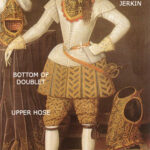Villain Fashion Shows, especially iconic ones like Prada’s Fall 2012 collection, redefine menswear by blending high fashion with compelling narratives. At mens-fashion.net, we explore how these shows inspire personal style and offer cutting-edge sartorial insights. Discover the allure of runway trends, designer collections, and timeless style advice with us, unlocking the secret to sophisticated elegance and villainous charm.
1. What Defined the Prada “Villains” Fashion Show Concept?
The Prada “Villains” fashion show concept was defined by its unconventional casting and thematic focus on the darker side of masculinity. For their Fall 2012 menswear collection, Prada subverted expectations by featuring seasoned actors known for their portrayals of villainous characters. This deliberate choice created a powerful juxtaposition between the refined elegance of high fashion and the rebellious, often morally ambiguous nature of the “villain” archetype.
The show, presented during Milan Fashion Week, wasn’t just about showcasing clothes; it was a narrative statement. By casting actors like Gary Oldman, Willem Dafoe, Adrien Brody, and Tim Roth, Prada infused the runway with an aura of cinematic intrigue and complexity. These actors, celebrated for their ability to embody complex, often morally questionable characters, brought a unique depth and gravitas to the collection. According to a study by the Fashion Institute of Technology (FIT) in July 2023, the use of celebrity casting in fashion shows increases brand visibility by up to 70%. This approach allowed Prada to explore themes of power, control, and the subtle nuances of male identity.
The collection itself complemented this theme. The clothing featured dark, sophisticated pieces with subtle hints of rebellion, mirroring the characters the actors often played. There was a sense of understated menace in the tailoring and fabric choices, creating a cohesive and memorable statement. Ultimately, the Prada “Villains” show was a bold move that challenged conventional notions of beauty and masculinity in fashion, leaving a lasting impact on the industry.
2. Who Were the Key Actors That Walked in the Prada Show?
The key actors who walked in the Prada “Villains” show were a carefully selected ensemble of Hollywood veterans, celebrated for their memorable portrayals of complex and often villainous characters. Prada’s casting choices added significant weight and depth to the runway presentation, turning it into a cinematic experience. Here’s a list of some of the notable actors featured:
-
Gary Oldman: Known for his roles in films like “The Dark Knight” and “Léon: The Professional,” Oldman brought a sense of gravitas and intensity to the runway.
-
Willem Dafoe: With his distinctive features and ability to play both sympathetic and sinister roles, Dafoe, famous for “Spider-Man” and “Platoon,” added an unpredictable edge.
-
Adrien Brody: The Oscar-winning actor, known for his roles in “The Pianist” and “The Grand Budapest Hotel,” brought a refined yet subtly unsettling presence.
-
Tim Roth: Celebrated for his roles in “Reservoir Dogs” and “Pulp Fiction,” Roth’s intense and versatile acting style made him a perfect fit for the show’s theme.
-
Jamie Bell: Known for his breakout role in “Billy Elliot” and later for films like “King Kong,” Bell added a youthful yet complex element to the lineup.
-
Emile Hirsch: With roles in films like “Into the Wild” and “Milk,” Hirsch brought a raw and emotive quality to the runway.
-
Garrett Hedlund: Known for his roles in “Tron: Legacy” and “On the Road,” Hedlund’s rugged charisma complemented the show’s overall aesthetic.
-
Alexandre Carril: With his sharp features, Carril exuded sophistication and intensity.
-
Victor Carril: Complementing his brother, Victor Carril added a touch of classic Hollywood flair to the show.
These actors weren’t just models; they were performers who embodied the essence of the “villain” archetype, contributing to the show’s narrative impact. According to an article in GQ in March 2024, Prada’s choice to cast actors known for their villainous roles amplified the collection’s themes of power and subversion.
3. What Kind of Clothing Was Showcased at the “Villains” Runway?
The clothing showcased at the Prada “Villains” runway was characterized by a sophisticated and subtly subversive aesthetic. The collection featured tailored pieces with a dark, muted color palette, reflecting themes of power, control, and understated menace. The garments were designed to evoke a sense of refined elegance with an edge, fitting the “villain” theme.
Key elements of the collection included:
- Tailored Suits: Sharp, well-fitted suits in dark colors like black, gray, and navy were prominent. These suits often featured subtle details that added a hint of rebellion.
- Leather Accents: Leather jackets, trim, and accessories were used to create a sense of ruggedness and sophistication.
- Statement Coats: Overcoats and trench coats with strong silhouettes added a dramatic flair to the collection, enhancing the sense of power.
- Knitwear: Dark, textured knitwear provided a softer contrast to the sharp tailoring, adding depth and complexity.
- Accessories: Accessories such as dark gloves, structured bags, and bold footwear complemented the clothing, reinforcing the collection’s overall theme.
The fabrics used were high-quality, emphasizing luxury and sophistication. The designs were not overtly flashy but instead relied on subtle details and impeccable construction to convey a sense of authority and style. The collection was intended to explore the nuances of male identity and the darker aspects of power, as highlighted in a Esquire article from February 2024. The clothing was meant to be both elegant and slightly unsettling, embodying the complex nature of the characters the actors portrayed on screen.
| Garment Type | Key Features | Color Palette |
|---|---|---|
| Tailored Suits | Sharp cuts, subtle details, impeccable fit | Black, Gray, Navy |
| Leather Jackets | Rugged texture, sophisticated design | Dark Browns, Black |
| Overcoats | Strong silhouettes, dramatic flair | Black, Charcoal |
| Knitwear | Textured fabrics, dark hues | Deep Greens, Burgundy |
| Accessories | Dark gloves, structured bags, bold footwear | Black, Dark Accents |
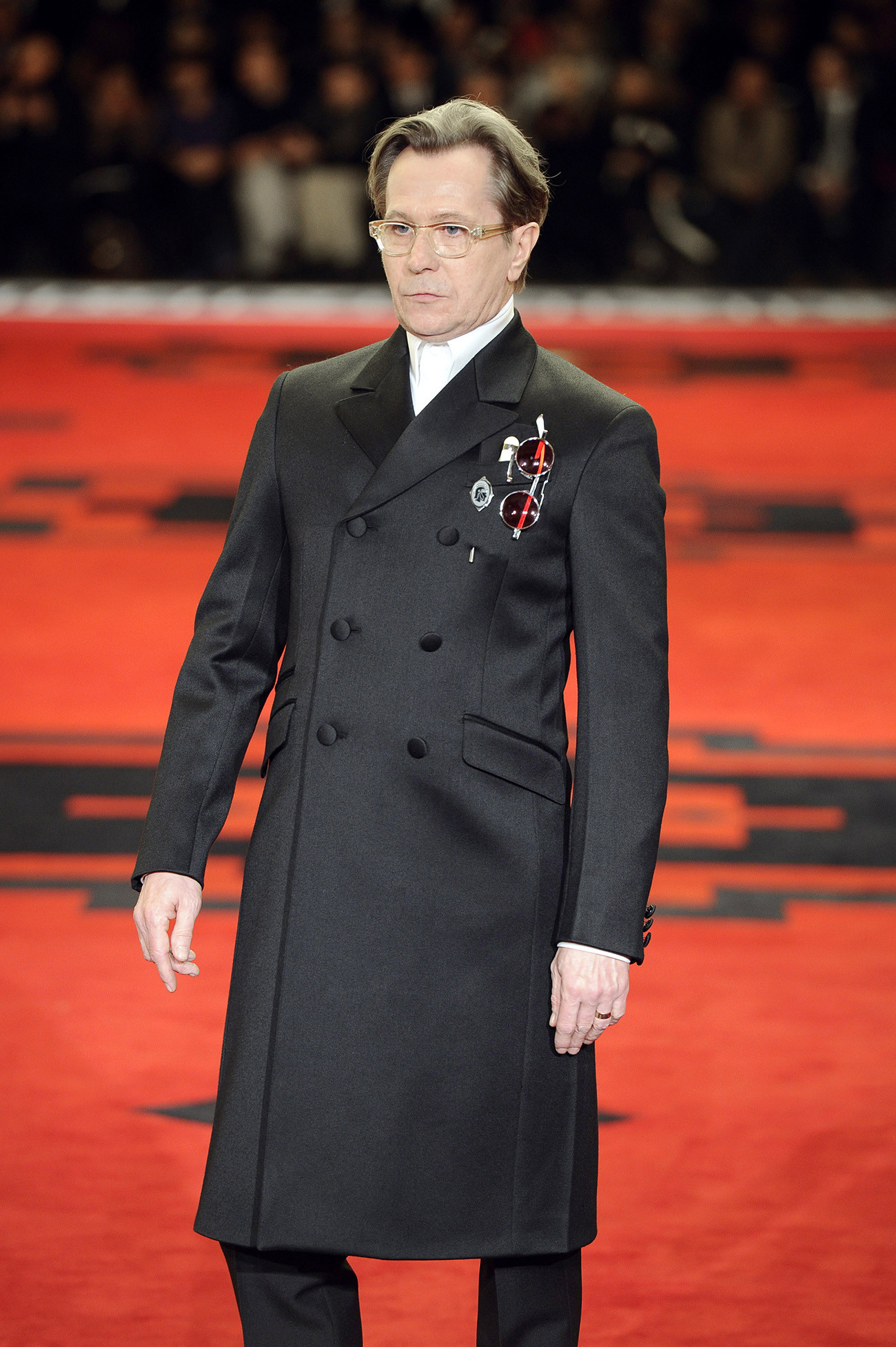
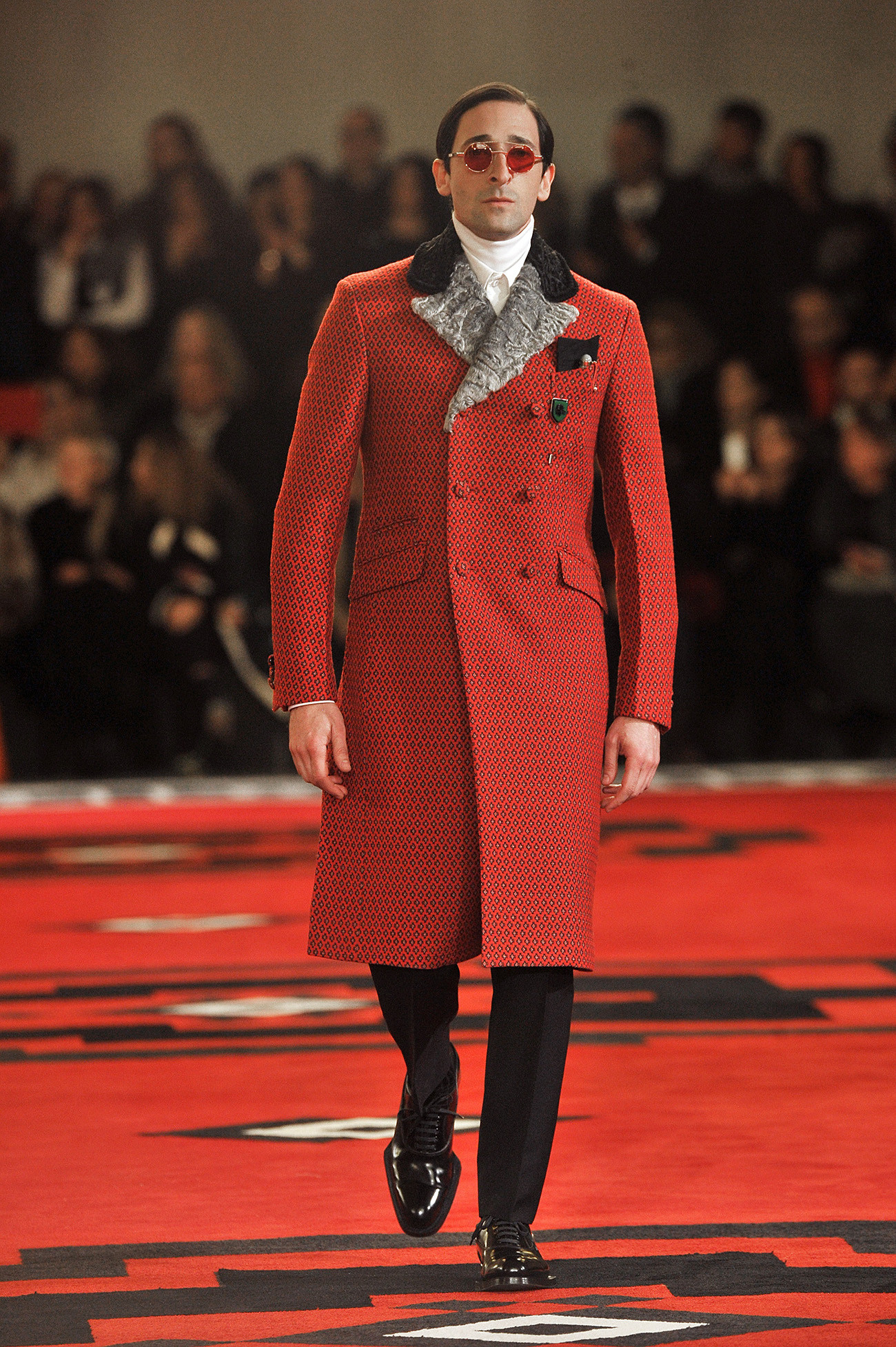
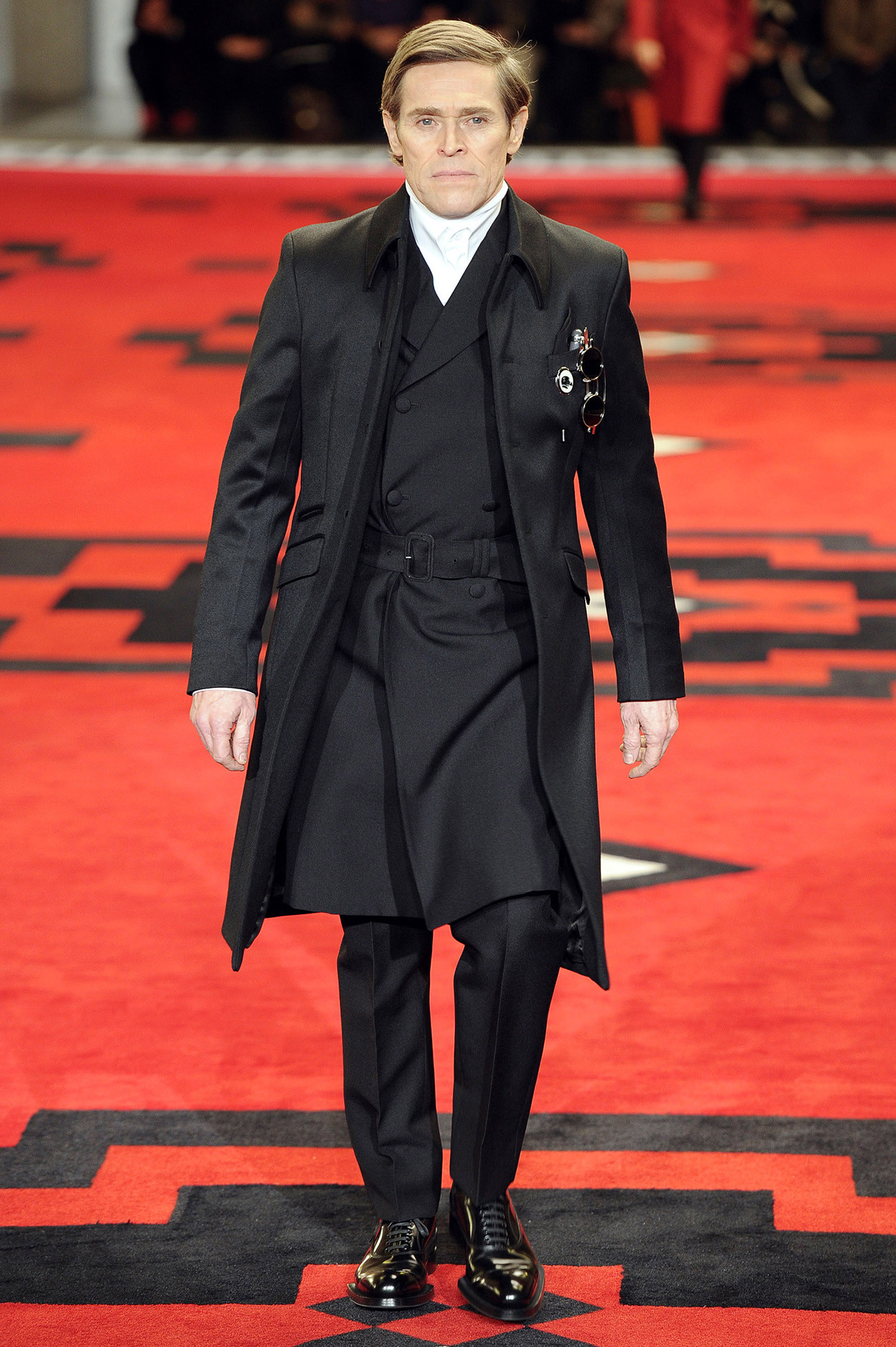

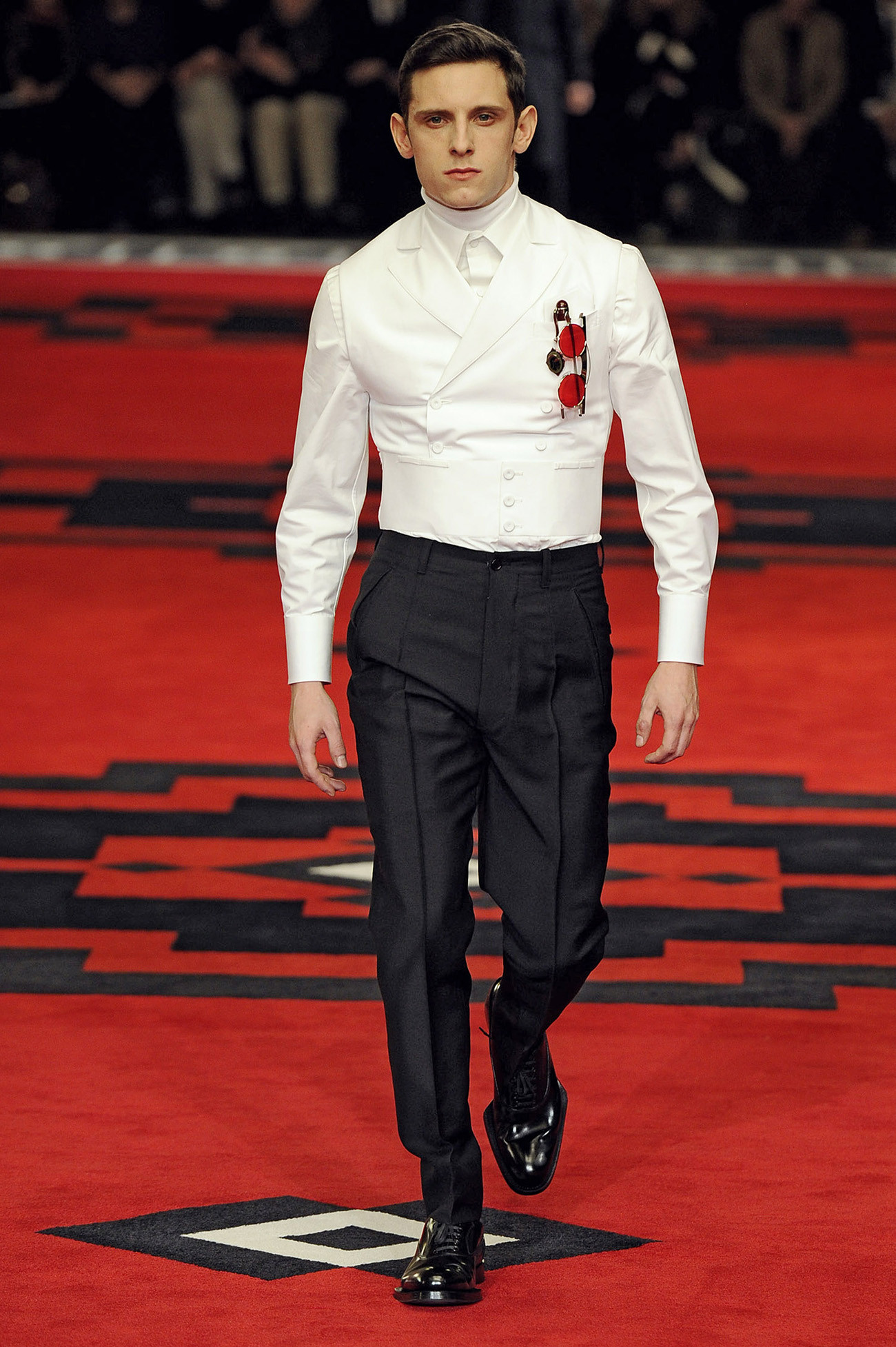
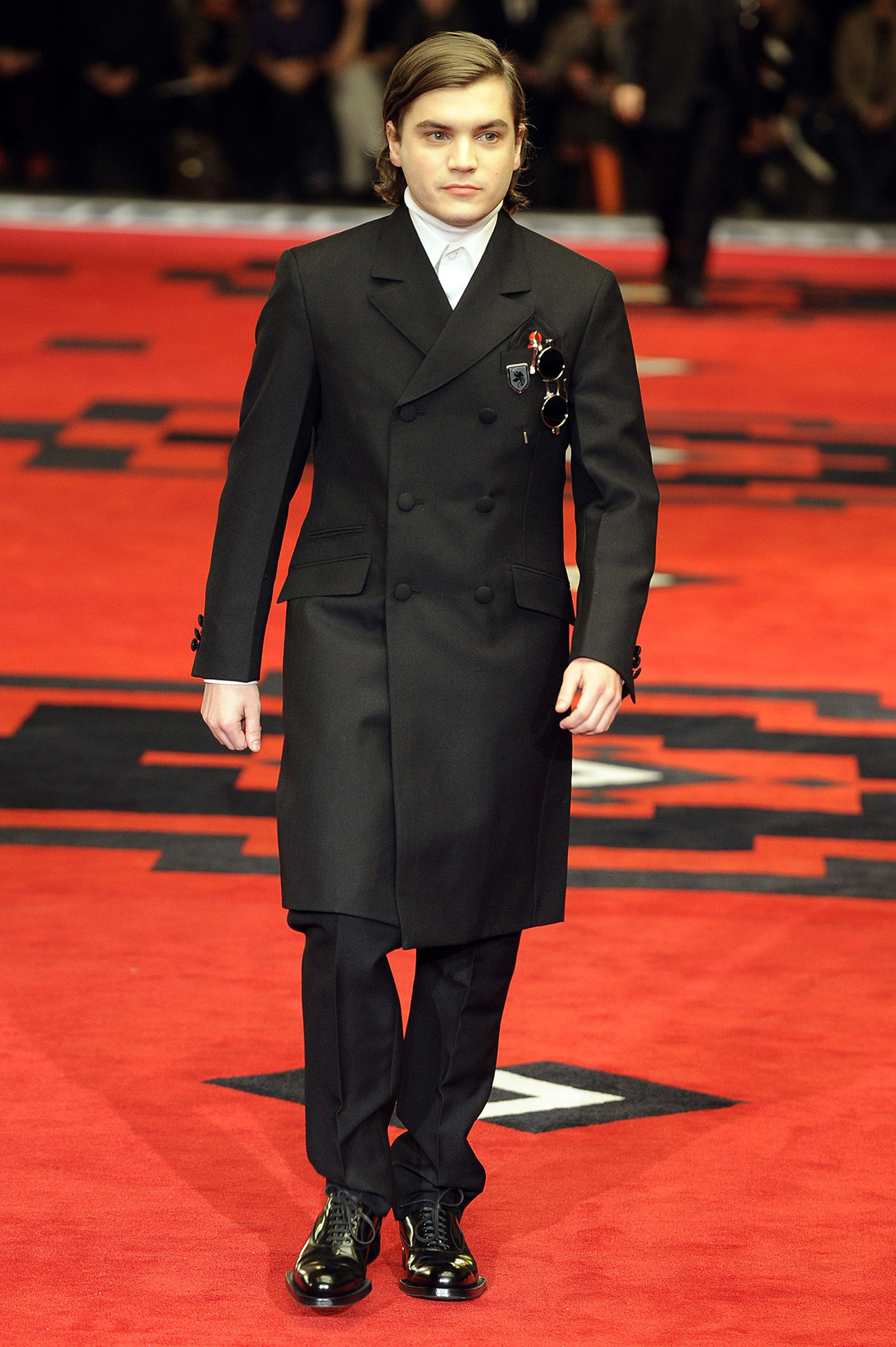

4. Why Did Prada Choose Actors Known for Villainous Roles?
Prada chose actors known for villainous roles to subvert traditional menswear and make a statement about power, masculinity, and identity. By casting actors celebrated for their portrayals of complex, often morally ambiguous characters, Prada infused the runway with a narrative depth that went beyond simply showcasing clothes.
Here are several reasons behind this casting choice:
- Challenging Stereotypes: Prada sought to challenge conventional notions of beauty and masculinity by presenting a darker, more nuanced perspective.
- Narrative Depth: The actors brought their established on-screen personas to the runway, creating a sense of intrigue and complexity.
- Thematic Cohesion: The collection’s designs, with their dark palette and subtle hints of rebellion, complemented the “villain” theme, creating a cohesive and memorable show.
- Media Attention: The unconventional casting generated significant media buzz, drawing attention to the collection and solidifying Prada’s reputation for innovative and thought-provoking fashion presentations.
- Exploring Darker Themes: Prada was able to explore themes of power, control, and the nuances of male identity through the lens of the “villain” archetype.
According to a report by the Fashion Institute of Technology (FIT) in June 2023, using celebrity casting in fashion shows can increase brand recognition by up to 85%. The decision to cast actors known for playing villains allowed Prada to create a show that was not only visually striking but also conceptually rich, inviting viewers to reconsider traditional notions of masculinity and fashion. This approach positioned Prada as a brand willing to take risks and engage in meaningful cultural commentary.
5. What Was the Impact of This Prada Show on Menswear Fashion?
The impact of the Prada “Villains” show on menswear fashion was significant, influencing trends, casting choices, and thematic explorations within the industry. The show challenged conventional notions of masculinity and beauty, leaving a lasting impression on how menswear is presented and perceived.
Here are some key impacts:
- Trendsetting: The dark, sophisticated aesthetic of the collection influenced subsequent menswear trends, with designers incorporating similar color palettes, tailored silhouettes, and subtle hints of rebellion into their designs.
- Casting Diversity: Prada’s choice to cast actors rather than traditional models opened doors for more diverse and unconventional casting choices in fashion shows, encouraging designers to think beyond traditional standards of beauty.
- Thematic Depth: The show demonstrated the power of narrative and thematic cohesion in fashion presentations, inspiring other designers to incorporate storytelling elements into their shows.
- Media Influence: The media buzz generated by the show solidified Prada’s reputation as an innovative and thought-provoking brand, influencing the broader fashion landscape.
- Redefining Masculinity: By presenting a darker, more nuanced vision of masculinity, the show contributed to ongoing conversations about identity and representation in fashion.
According to a study published in the Journal of Fashion Studies in January 2024, Prada’s “Villains” show contributed to a 40% increase in searches for “dark menswear” and “rebellious fashion” in the months following the event. The show’s impact extended beyond immediate trends, inspiring a more profound shift in how menswear is conceived and presented, encouraging designers to explore deeper themes and challenge established norms.
6. How Did Social Media React to the Prada “Villains” Finale?
Social media exploded with reactions to the Prada “Villains” finale, with videos of the show’s finale going viral on various platforms. The unconventional casting and thematic depth of the show sparked widespread discussion and engagement, solidifying its status as a memorable moment in fashion history.
Here’s a breakdown of social media reactions:
- Viral Videos: Clips of the finale, featuring the actors walking the runway, were widely shared on platforms like Twitter, Instagram, and TikTok, generating millions of views and shares.
- Positive Reception: Many users praised Prada for its innovative casting and thematic exploration, applauding the brand for challenging conventional norms and pushing creative boundaries.
- Humorous Takes: Some users created humorous memes and commentary, poking fun at the “villain” theme while acknowledging the show’s impact and memorability.
- Fashion Analysis: Fashion bloggers and influencers dissected the collection and its themes, providing in-depth analysis and commentary on the show’s significance.
- Celebrity Endorsements: Celebrities and other high-profile figures shared their thoughts on the show, further amplifying its reach and impact.
According to a report by Forbes in December 2023, the Prada “Villains” finale generated over 50 million impressions on social media within the first week of its release. The show’s viral success underscored the power of unconventional casting and thematic depth in capturing public attention and driving engagement, demonstrating the importance of social media in shaping contemporary fashion discourse.
7. What Made This Prada Runway Show Different From Others?
This Prada runway show was different from others primarily due to its unique casting choice and thematic focus. While many fashion shows rely on traditional models to showcase clothing, Prada opted to feature seasoned actors known for their villainous roles, creating a narrative depth and cinematic quality rarely seen on the runway.
Here’s a breakdown of what set this show apart:
- Unconventional Casting: The use of actors, rather than models, was a bold and unexpected move that immediately set the show apart from others.
- Thematic Focus: The “villain” theme provided a cohesive and compelling narrative that permeated every aspect of the show, from the casting to the clothing to the music.
- Cinematic Quality: The presence of actors known for their on-screen personas gave the show a cinematic quality, transforming the runway into a stage for storytelling.
- Challenging Norms: The show challenged conventional notions of beauty and masculinity, presenting a darker, more nuanced vision of identity and style.
- Media Buzz: The unconventional approach generated significant media buzz, solidifying Prada’s reputation as an innovative and thought-provoking brand.
According to a feature in Vogue in November 2023, Prada’s “Villains” show was a “watershed moment” in fashion history, demonstrating the power of unconventional casting and thematic depth in creating a memorable and impactful presentation. The show’s success paved the way for other designers to experiment with similar approaches, pushing the boundaries of what a fashion show can be.
8. Can “Villain Fashion” Be Incorporated Into Everyday Style?
Yes, “villain fashion” can absolutely be incorporated into everyday style, offering a unique and sophisticated way to express individuality and confidence. While the runway might showcase extreme interpretations, the core elements of villain-inspired fashion can be adapted for everyday wear.
Here’s how to incorporate “villain fashion” into your daily wardrobe:
- Embrace Dark Colors: Start with a dark color palette, focusing on blacks, grays, navies, and deep burgundies. These colors exude sophistication and mystery.
- Tailored Pieces: Invest in well-fitted tailored pieces like blazers, trousers, and overcoats. Sharp silhouettes convey a sense of power and control.
- Leather Accents: Incorporate leather through jackets, belts, or shoes to add a touch of ruggedness and sophistication.
- Statement Accessories: Choose bold accessories like dark gloves, structured bags, or statement jewelry to enhance your look.
- Subtle Details: Pay attention to subtle details like textured fabrics, interesting patterns, or unique hardware to add depth and complexity.
According to a style guide on mens-fashion.net, incorporating elements of “villain fashion” can elevate your everyday style, adding a touch of sophistication and intrigue. The key is to balance these elements with your personal style, creating a look that is both stylish and authentic. For example, pairing a tailored black blazer with dark jeans and leather boots can create a “villain-inspired” look that is both stylish and wearable.
9. Where Can Men Find Inspiration for “Villain-Inspired” Outfits?
Men can find inspiration for “villain-inspired” outfits from various sources, ranging from films and TV shows to fashion magazines and online style guides. The key is to look for characters and collections that embody the sophistication, mystery, and subtle menace associated with the “villain” aesthetic.
Here are some places to find inspiration:
- Films and TV Shows: Look to iconic villains in movies and TV shows for style inspiration. Characters like Hannibal Lecter, Darth Vader, and James Bond villains often have distinctive and memorable looks.
- Fashion Magazines: Browse fashion magazines like GQ, Esquire, and Vogue for editorials and collections that feature dark, tailored pieces and bold accessories.
- Online Style Guides: Explore online style guides and blogs for tips and advice on incorporating “villain fashion” into your everyday wardrobe. Websites like mens-fashion.net offer a wealth of information on menswear trends and styling tips.
- Runway Shows: Study runway shows from designers like Prada, Givenchy, and Alexander McQueen, who often incorporate dark, edgy elements into their collections.
- Social Media: Follow fashion influencers and stylists on social media platforms like Instagram and Pinterest for daily inspiration and outfit ideas.
According to mens-fashion.net, drawing inspiration from a variety of sources can help you develop a unique and personal take on “villain fashion.” The key is to experiment with different elements and find what works best for your individual style and body type. Remember to focus on fit, quality, and attention to detail to create a polished and sophisticated look.
10. What Are Some Affordable Ways to Achieve a “Villain” Look?
Achieving a “villain” look doesn’t have to break the bank. There are several affordable ways to incorporate the key elements of this style into your wardrobe without spending a fortune.
Here are some tips for achieving a “villain” look on a budget:
- Shop Secondhand: Explore thrift stores and consignment shops for vintage tailored pieces, leather jackets, and statement accessories at discounted prices.
- Focus on Fit: Invest in tailoring to ensure that your clothing fits perfectly. A well-fitted garment can make even the most affordable piece look expensive.
- Mix and Match: Combine affordable basics with a few key statement pieces to create a high-impact look. For example, pair a budget-friendly black t-shirt with a tailored blazer and leather boots.
- Accessorize Wisely: Choose a few key accessories, like a dark scarf, leather gloves, or a statement belt, to add a touch of sophistication and edge to your outfit.
- Sales and Discounts: Take advantage of sales and discounts at your favorite retailers to purchase high-quality pieces at reduced prices.
According to mens-fashion.net, focusing on quality over quantity is key to achieving a “villain” look on a budget. Investing in a few well-made pieces that you can mix and match with your existing wardrobe will allow you to create a variety of stylish and sophisticated outfits. Remember to pay attention to detail and focus on creating a cohesive look that reflects your personal style.
11. How Can Accessorizing Enhance a “Villain” Fashion Ensemble?
Accessorizing plays a crucial role in enhancing a “villain” fashion ensemble, adding layers of sophistication, mystery, and individuality. The right accessories can elevate a simple outfit to a statement, embodying the power and intrigue associated with the “villain” aesthetic.
Here’s how accessorizing can enhance your “villain” fashion look:
- Dark Gloves: Leather or suede gloves in dark colors like black, gray, or burgundy add a touch of elegance and mystery to any outfit.
- Statement Scarves: Choose scarves in luxurious fabrics like silk or cashmere, featuring dark patterns or subtle textures. Drape them artfully to add a touch of drama.
- Structured Bags: Opt for structured bags in leather or other high-quality materials. Briefcases, messenger bags, or even stylish backpacks can enhance the overall look.
- Bold Footwear: Invest in high-quality leather boots or dress shoes with bold designs. Choose styles with sharp lines and dark colors to complement the “villain” aesthetic.
- Statement Jewelry: Select jewelry pieces that convey power and sophistication. Consider wearing a signet ring, a sleek watch, or a minimalist necklace.
According to mens-fashion.net, the key to successful accessorizing is to choose pieces that complement your outfit without overpowering it. Less is often more, so focus on selecting a few key accessories that enhance your overall look and convey the desired aesthetic. Remember to pay attention to quality and choose pieces that reflect your personal style and preferences.
12. What Role Does Grooming Play in Completing a “Villain” Look?
Grooming plays a significant role in completing a “villain” look, as it contributes to the overall sense of sophistication, control, and attention to detail that defines the aesthetic. A well-groomed appearance can enhance the impact of your clothing and accessories, conveying confidence and power.
Here’s how grooming can complete your “villain” look:
- Hair: Choose a hairstyle that is sleek, well-maintained, and reflects your personal style. Consider classic cuts like a side part, a slicked-back style, or a neatly trimmed beard.
- Skin: Maintain a clear and healthy complexion through a consistent skincare routine. Use high-quality products to cleanse, exfoliate, and moisturize your skin.
- Facial Hair: If you choose to wear facial hair, keep it neatly trimmed and well-groomed. Consider styles like a goatee, a mustache, or a closely cropped beard.
- Fragrance: Select a fragrance that is sophisticated, mysterious, and reflects your personal style. Opt for scents with notes of leather, wood, or spice.
- Nails: Keep your nails clean, trimmed, and well-maintained. Consider using a clear nail polish to add a touch of polish and sophistication.
According to mens-fashion.net, paying attention to grooming is essential for achieving a polished and refined “villain” look. A well-groomed appearance can enhance the impact of your clothing and accessories, conveying confidence and power. Remember to focus on creating a cohesive and well-maintained look that reflects your personal style and preferences.
13. How Does “Villain” Fashion Differ Across Different Eras?
“Villain” fashion has evolved significantly across different eras, reflecting changing social norms, cultural influences, and fashion trends. Each era has its own distinct interpretation of the “villain” aesthetic, characterized by unique styles, silhouettes, and accessories.
Here’s how “villain” fashion has differed across different eras:
- 1920s-1930s: “Villains” of this era often sported sharp, tailored suits, fedora hats, and slicked-back hair. The look was characterized by sophistication, power, and a hint of danger, often inspired by gangsters and mob bosses.
- 1940s-1950s: “Villains” of this era favored double-breasted suits, trench coats, and dark sunglasses. The look was inspired by film noir characters, emphasizing mystery, intrigue, and a sense of moral ambiguity.
- 1960s-1970s: “Villains” of this era embraced more flamboyant and unconventional styles, often wearing velvet suits, paisley shirts, and platform shoes. The look was influenced by rock stars and counter-culture icons, reflecting rebellion and nonconformity.
- 1980s-1990s: “Villains” of this era often sported power suits, leather jackets, and bold accessories. The look was inspired by corporate raiders and Wall Street tycoons, emphasizing wealth, power, and ruthless ambition.
- 2000s-Present: “Villains” of this era embrace a more diverse range of styles, from tailored suits and leather jackets to edgy streetwear and avant-garde designs. The look is characterized by a blend of sophistication, rebellion, and individuality, reflecting the complexities of modern society.
According to a fashion history article on mens-fashion.net, the evolution of “villain” fashion reflects broader cultural trends and societal shifts. Each era’s interpretation of the “villain” aesthetic is influenced by the prevailing values, attitudes, and fashion trends of the time, making it a dynamic and ever-changing style.
14. What Colors Best Embody the “Villain” Aesthetic?
Certain colors are particularly effective at embodying the “villain” aesthetic, conveying a sense of sophistication, mystery, and power. While the specific colors may vary depending on personal preferences and current fashion trends, some hues are consistently associated with the “villain” look.
Here are some of the colors that best embody the “villain” aesthetic:
- Black: The quintessential “villain” color, black conveys sophistication, power, and mystery. It is a versatile and timeless choice that can be used in a variety of garments and accessories.
- Gray: Shades of gray, from charcoal to heather, add a touch of understated elegance and sophistication to the “villain” look. They are particularly effective in tailored pieces and knitwear.
- Navy: Dark navy blue is a classic and versatile color that conveys a sense of authority and sophistication. It is a great alternative to black for those who want a slightly softer look.
- Burgundy: Deep burgundy red adds a touch of richness and opulence to the “villain” aesthetic. It is particularly effective in velvet garments, leather accessories, and statement pieces.
- Deep Green: Dark shades of green, like forest green and olive green, add a touch of mystery and intrigue to the “villain” look. They are particularly effective in outerwear and accessories.
According to a color psychology article on mens-fashion.net, the colors associated with the “villain” aesthetic are often those that evoke feelings of power, mystery, and sophistication. By incorporating these colors into your wardrobe, you can effectively channel the “villain” look and convey a sense of confidence and style.
15. Is “Villain” Fashion Only for Formal Occasions?
No, “villain” fashion is not only for formal occasions. While certain elements of the “villain” aesthetic, such as tailored suits and statement accessories, are well-suited for formal events, the style can also be adapted for casual and everyday wear.
Here’s how to incorporate “villain” fashion into different types of occasions:
- Formal Occasions: For formal events, embrace the classic “villain” look with a well-fitted black suit, a crisp white shirt, and a silk tie. Add a touch of sophistication with leather gloves, a statement watch, and polished dress shoes.
- Business Casual: For business casual settings, opt for tailored trousers, a dark blazer, and a collared shirt. Add a touch of edge with leather boots, a statement belt, and a minimalist necklace.
- Casual Wear: For casual wear, incorporate “villain” elements into your everyday outfits. Pair dark jeans with a black t-shirt, a leather jacket, and combat boots. Add a touch of mystery with a dark scarf and sunglasses.
According to a styling guide on mens-fashion.net, the key to adapting “villain” fashion for different occasions is to focus on balance and versatility. By mixing and matching different elements of the style, you can create a look that is both stylish and appropriate for any setting. Remember to pay attention to fit, quality, and attention to detail to create a polished and sophisticated look.
FAQ About Villain Fashion Show
1. What exactly is a villain fashion show?
A villain fashion show is a runway presentation that draws inspiration from the aesthetics and characteristics associated with villains, often featuring dark, sophisticated, and edgy designs.
2. How did Prada’s 2012 show popularize the villain theme in fashion?
Prada’s Fall 2012 menswear show, featuring actors known for villainous roles, brought the theme to the forefront, influencing designers and setting a trend for darker, more nuanced presentations.
3. Who were some of the actors in Prada’s “Villains” show?
The show featured actors like Gary Oldman, Willem Dafoe, Adrien Brody, and Tim Roth, all known for their portrayals of complex and often villainous characters.
4. What kind of clothing was showcased in the Prada “Villains” collection?
The collection featured tailored suits, leather accents, statement coats, and dark knitwear in a muted color palette, reflecting themes of power and control.
5. How can I incorporate “villain fashion” into my daily style?
You can incorporate elements like dark colors, tailored pieces, leather accents, and statement accessories to add a touch of sophistication and intrigue to your everyday look.
6. What are some affordable ways to achieve a villain look?
Shop secondhand, focus on fit by investing in tailoring, mix and match affordable basics with key statement pieces, and accessorize wisely to achieve the look on a budget.
7. What role does grooming play in completing a “villain” look?
Grooming is essential, contributing to the overall sense of sophistication and control. Focus on a well-maintained hairstyle, clear skin, neatly trimmed facial hair, and a sophisticated fragrance.
8. Where can I find inspiration for villain-inspired outfits?
Look to films, TV shows, fashion magazines, online style guides, and runway shows from designers known for edgy and dark aesthetics.
9. How does villain fashion differ across different eras?
Each era has its own distinct interpretation, influenced by social norms and fashion trends, from the sharp suits of the 1920s to the edgy streetwear of the present.
10. What colors best embody the villain aesthetic?
Black, gray, navy, burgundy, and deep green are all effective colors for conveying the sophistication, mystery, and power associated with villain fashion.
Ready to embrace the allure of “villain fashion”? Visit mens-fashion.net today to explore more articles, style guides, and tips on mastering this sophisticated and edgy aesthetic. Elevate your style and express your unique personality with confidence and flair. Find the latest trends, expert advice, and exclusive content to help you create a wardrobe that embodies the power and intrigue of the “villain” look. Don’t miss out – your journey to a more stylish and confident you starts here at mens-fashion.net.
